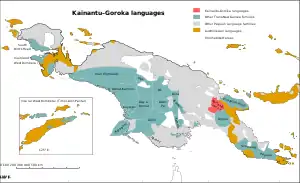Kainantu–Goroka languages
The Kainantu–Goroka language are a family of Papuan languages established by Arthur Capell in 1948 under the name East Highlands. They formed the core of Stephen Wurm's 1960 East New Guinea Highlands family (the precursor of Trans–New Guinea), and are one of the larger branches of Trans–New Guinea in the 2005 classification of Malcolm Ross.
| Kainantu–Goroka | |
|---|---|
| East Highlands | |
| Geographic distribution | highlands of Kainantu and Goroka, Eastern Highlands Province, Papua New Guinea |
| Linguistic classification | Trans–New Guinea
|
| Subdivisions | |
| Glottolog | kain1273 |
 Map: The Kainantu–Goroka languages of New Guinea
The Kainantu–Goroka languages
Other Trans–New Guinea languages
Other Papuan languages
Austronesian languages
Uninhabited | |
Languages
The constituent Kainantu and Goroka families are clearly valid groups, and both William A. Foley and Timothy Usher consider their TNG identity to be established. The languages are,[1]
- Goroka family
- Kainantu family
Pronouns
The pronouns reconstructed by Ross (2005) for proto-Kainantu–Goroka, proto-Kainantu, and proto-Goroka are as follows:
proto-Kainantu–Goroka sg pl 1 *ná *tá[za] 2 *ká[za] *tá-na- 3 *[y]á, *wá *yá[na] proto-Kainantu sg du pl 1 *né *té[ze]- *té[ze] 2 *é[ze] *[te]né- 3 *wé
proto-Goroka sg pl 1 *ná *tá[za] 2 *ká *tá-na-gaza, *tí-na-gaza 3 *[y]á *[y]á-na-gaza, *í-na-gaza
The possessive forms are:
proto-Kainantu–Goroka sg pl 1 *na-i *ta-i 2 *ka *tana-i 3 *[y]a, *wa *ya-i, *yana-i
Evolution
Kainantu–Goroka reflexes of proto-Trans-New Guinea (pTNG) etyma are:[2]
- are ‘ear’ < *kand(e,i)k(V]
- nu ‘louse’ < *niman
- ato ‘ear’ < *kand(e,i)k(V]
- ir ‘tree’ < *inda
- (n)am ‘breast’ < *amu
- nume ‘louse’ < *niman
- kubu ‘short’ < *k(a,u)tu(p,mb)aC
- mi- ‘give’ < *mV-
- na- ‘eat’ < *na-
- numaa ‘louse’ < *niman
- mi- ‘give’ < *mV-
- amune ‘egg’ < *mun(a,i,u)ka
- kasa ‘new’ < *kVndak
- mone ‘nose’ < *mundu
- ami ‘breast’ < *amu
- mut ‘belly’ < *mundun ‘internal organs’
- mina- ‘stay’ < *mVna-
- nogoi ‘water < *[n]ok, (tu)
- nima ‘louse’ < *niman
- me- ‘give’ < *mV-
Innovations in proto-Kainantu-Goroka replacing proto-Trans-New Guinea forms:[2]
- *tá[za] ‘1pl’ replaces pTNG *ni, *nu
- *tá-na ‘2pl’ replaces pTNG *ŋgi, *ja
- genitive forms ending in *-i
Vocabulary
Gorokan basic vocabulary from William A. Foley (1986):[3]
gloss Proto-Gorokan Gende Siane Benabena Kamono–Yagaria Fore ‘two’ *tote ogondrari lele loe lole tara ‘man’ *we vei we vo ve wa ‘water’ *no(k) nogoi no nagami ni(na) wani ‘fire’ tuva yo logo hali yakuʔ ‘tree’ *ya izo ya yafa yava yaː ‘leaf’ kuruma aila haya(ʔa) haeya aʔyeʔ ‘root’ *supa tovaya lufawa lufusa(ʔa) havu aubu ‘house’ *nom nomu numu(na) no(hi) yo(na) naːmaʔ ‘breast’ *ami ami- ami(na) amiha(ʔa) ami(maʔa) nono ‘tooth’ *wa va(iza) auma yogo(ʔa) (ä)vep (a)wa ‘bone’ *yampu yami- auma felisa(ʔa) (a)pu(va) (a)yaːmpu ‘ear’ *ke/a ka- ka(la) (e)kesa(ʔa) (ä)geta (a)ge ‘hair’ *yoka yogo yowa(la) oka(ʔa) (a)yokaʔ (a)yaːʔ ‘leg’ *kia kia- kiya(na) gigusa(ʔa) (a)gia (a)gisaː ‘blood’ *kota mamia- wanu golaha(ʔa) gola(na) koraːʔ ‘hand’ *ya ya a(na) yaha(ʔa) (ä)ya ya ‘egg’ *mut mura mula mu(ʔa) mu(na) amuʔ ‘sun’ *po po fo yafi yafo yaːbu ‘axe’ *tu tu luna lu lu tuʔ ‘netbag’ *ko ko owo gu(ʔi) gu(na) koʔ ‘eat’ *na- na- n- na- no- na- ‘die’ *puti- pri- fol- fili- fili- puri- ‘say’ *si- ti- l- li- hi- i- ‘give’ *mi- imi- om- m- mi- mi- ‘big’ *(n)ampa namba namba napa legepa tabe
Kainantu basic vocabulary from William A. Foley (1986):[3]
gloss Awa Auyana Gadsup Tairora ‘two’ tɔtare kaiʔa kaantani taaraʔanta ‘man’ wɛ waiya banta bainti ‘water’ no nomba nomi namari ‘fire’ ira irama ikai iha ‘tree’ ta taima yaani katari ‘leaf’ ɔnɔ anama anai mare ‘root’ anuʔ anuʔa anuʔi tuʔa ‘house’ nɔ naamba maʔi naabu ‘breast’ nɔ naamba naami naama ‘tooth’ awɛ awaiyamba abakuni aabai ‘bone’ ayɔnta ayaantamba ayampai buhaarima ‘ear’ ɔre aʔa aakami aato ‘hair’ (a)yɔra aayara -nyoi kauhi ‘leg’ ai aisamima akani aiʔu ‘blood’ nɛe naema naarei naare ‘hand’ ayɔnobeh ayamba aayaami kauʔu ‘egg’ au auma amuʔi auru ‘sun’ popoʔnah aabauma ikona kauri ‘axe’ konaro koraroba kuntaʔi kaarima ‘netbag’ unɔ unaamba unaami uta ‘eat’ nɔno nare naano naana ‘die’ pukire pukai pukono ʔutubiro ‘say’ iraruwo siyo seʔu tiena ‘give’ awiʔ ami ameno amina ‘big’ aanotɔ anomba inoʔna nora
See also
- East New Guinea Highlands languages, an expansion of Kainantu–Goroka in Wurm 1975, which was later abandoned by Ross due to a lack of unifying morphological data.
References
- (NewGuineaWorld)
- Pawley, Andrew; Hammarström, Harald (2018). "The Trans New Guinea family". In Palmer, Bill (ed.). The Languages and Linguistics of the New Guinea Area: A Comprehensive Guide. The World of Linguistics. 4. Berlin: De Gruyter Mouton. pp. 21–196. ISBN 978-3-11-028642-7.
- Foley, William A. (1986). The Papuan Languages of New Guinea. Cambridge: Cambridge University Press. ISBN 0-521-28621-2.
External links
- Timothy Usher, New Guinea World, Kainantu
Bibliography
- Ross, Malcolm (2005). "Pronouns as a preliminary diagnostic for grouping Papuan languages". In Andrew Pawley; Robert Attenborough; Robin Hide; Jack Golson (eds.). Papuan pasts: cultural, linguistic and biological histories of Papuan-speaking peoples. Canberra: Pacific Linguistics. pp. 15–66. ISBN 0858835622. OCLC 67292782.
- Ross, Malcolm. 2014. Proto-Kainantu-Goroka. TransNewGuinea.org.
- Ross, Malcolm. 2014. Proto-Goroka. TransNewGuinea.org.
- Ross, Malcolm. 2014. Proto-Kainantu. TransNewGuinea.org.
- Proto-Eastern Kainantu-Goroka. TransNewGuinea.org. From Scott, G. 1978. The Fore language of Papua New Guinea. Canberra: Pacific Linguistics.
- Proto-Eastern-Central Gorokan. TransNewGuinea.org. From Scott, G. 1978. The Fore language of Papua New Guinea. Canberra: Pacific Linguistics.